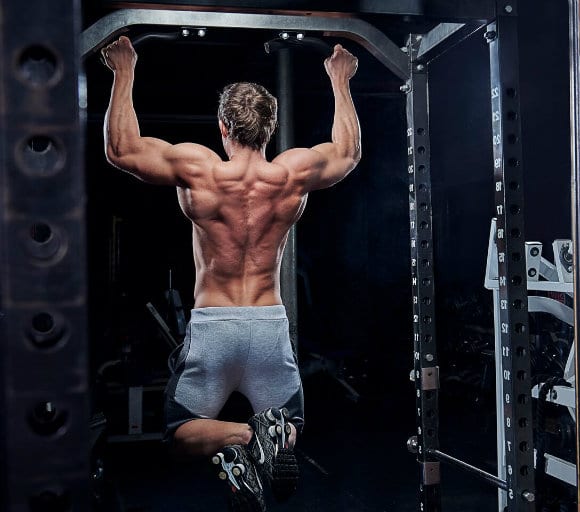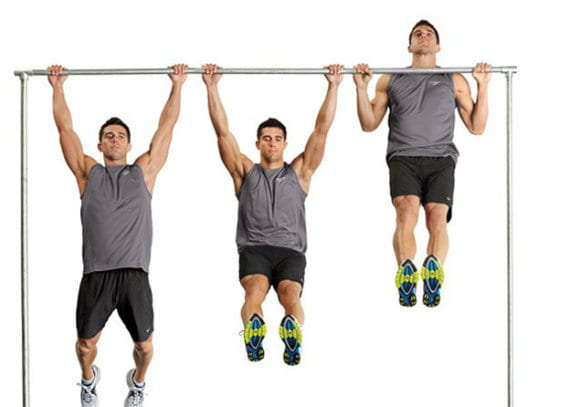By the healthiergang writer , student in Medicine and Surgery.
Pull ups
The exercise of pull ups exercise is considered multiarticular more complete to train the back muscles. The main engine is the Great Dorsal (Latissimus Dorsi for the most faithful), a large flat muscle with a triangular shape, belonging to the Mm. Superficial of the back.
It is the largest muscle in the entire human body and originates from Lumbosacral fascia (last 6 thoracic vertebrae, all lumbar and sacral portion), inconstantly from the lower portion of the lateral margin of the scapula, from the lateral margin of the iliac crest and from the last 4 ribs, to get to insert, rotating with its fibers of about 180 ° on the posterior lip of the bicipital groove of the humerus.
With these peculiarities, the action takes place in an adduction, extension and internal rotation of the humerus. In synergy with the Great Dorsal, returning to the traction exercise, other muscles of both the back and appendages intervene, with different intensity and modalities depending on the grip and the position of arrival at the bar: arm and forearm muscles (elbow flexion), trapezius and rhomboids (scapular adduction), deltoid, deep muscles of the back, triceps and even some bundles of the pectoralis major muscle (the lower ones are involved in shoulder extension).
How are they performed?
At the beginning of the exercise the athlete hangs on the bar, with the which outlet you prefer (later we will analyze the possible variants), approximately at shoulder height; a contracted abdomen and abducted shoulder blades are a good idea to make exercise safe.
From this position, with the arms fully extended, you try to bring your chest up until it touches the bar. The movement is thus complete, but in the last part of the ascent approximately between the chin and the chest, thehumerus is pushed further back and the work is carried out mainly by the long head of the triceps and the posterior bundles of the deltoid, quite small muscles, which is why the last stretch is always the most difficult.

If we want to reduce the role of these muscles from the exercise, we finish the gesture bringing the chin over the bar, considered valid in all competitions that require the execution of pull-ups.
The analysis certainly begins with:
# 1. Approach to the bar
the best way to tighten it is with the 4 fingers (at the junction between these and the palm of the hand) and with the thumb to oppose the same bar, which guarantees an alignment of the wrist and a greater decontraction of the Mm of the forearm, avoiding to tire them prematurely.
#2. The grip can be supine, prone or neutral
In the first (palms towards you) there will be a greater involvement of the brachial biceps in the flexion of the elbow and a more advantageous position for the grand dorsal, which is expressed in greater simplicity of execution and explosiveness; however, there is the drawback of not being able to fully rotate the arms, a condition compensated by the joint capsules which in the long run can become inflamed
In the prone, unlike the first, the great dorsal starts in a disadvantaged condition (it is not stretched to the maximum) and will be assisted by the brachioradialis and brachialis muscles, certainly less strong than the biceps and for this reason the execution will be more difficult; the neutral grip (thumbs towards you) is a good compromise between the previous two, but specific positions are required to be able to perform it.
# 3. Hand width
Generally the width of the shoulders is the preferable one, even if a tighter step allows a greater explosiveness given by the greater elongation of the great dorsal and large pectoral, while a greater step, for those who already have good strength guarantees to reduce the ROM, decreasing the gap from the bar.
# 4. The trajectory
The ideal one is definitely the straight one, starting under the bar with the body in extension and arriving with the chin above the bar; the further you move away from this trajectory, the more difficult it is to exercise.
# 5. The elbows and shoulder blades
the elbows must be turned down and pushed back during the ascent, while the shoulder blades must be retracted and the trapezes contracted.
#6. Core
It has a very important function in stabilizing, especially to avoid oscillations and deviations from the vertical.
# 7. Cross your legs
There are those who argue that this attitude leads to a postural imbalance but it turns out to be so irrelevant that it does not change much whether crossing them or not.
variants
The "classic" version of the tractions is that a presa property, commonly defined pull-up. The version with the supine grip, chin-up, slightly changes the forces involved, because the muscles in question are always the same, but with a different distribution of effort, especially as regards the upper backbones and the forearm muscles (more involved in pull-ups) and bundles of the lower latissimus dorsal and biceps brachialis (more involved in chin-ups).
For beginners it is useful to start with the help of rubber bands, which facilitate the ascent phase, placed between the bar and the knees, under the feet or under the arms. For those who have about twenty spun pull-ups in their luggage, you can think of something different, like i kipping pull-up.

Here is the variant kipping, where the aim is to carry out as many as possible in the shortest possible time. In this particular version, it almost seems that the athlete is cheating or that the muscles are not activated and stimulated correctly while instead the effort is still considerable since it moves away, and a lot, from the ideal line. The exercise is very technical and the important things to learn are the following.
# 1 Oscillation: hanging from the bar, swing your shoulders forward and legs back, so that you form a sort of arch with your body. With a swing then bring the shoulders back and the legs forward, forming a mirror arc with the body compared to the first. Practice until you can swing smoothly without bending your elbows.
# 2 The Knee Push: when in the rear swing position, push yourself with your knees to bring your body closer to the bar. In this phase of the movement it is essential to seize the right moment, otherwise you lose momentum and power.
# 3 Traction: rise towards the bar, extending the pelvis with force, up to overcome it with the chin, the movement does not count if the chin does not pass the bar. Without hesitation, push yourself away from the bar with your arms to start again trying to exploit the pendulum effect.


























